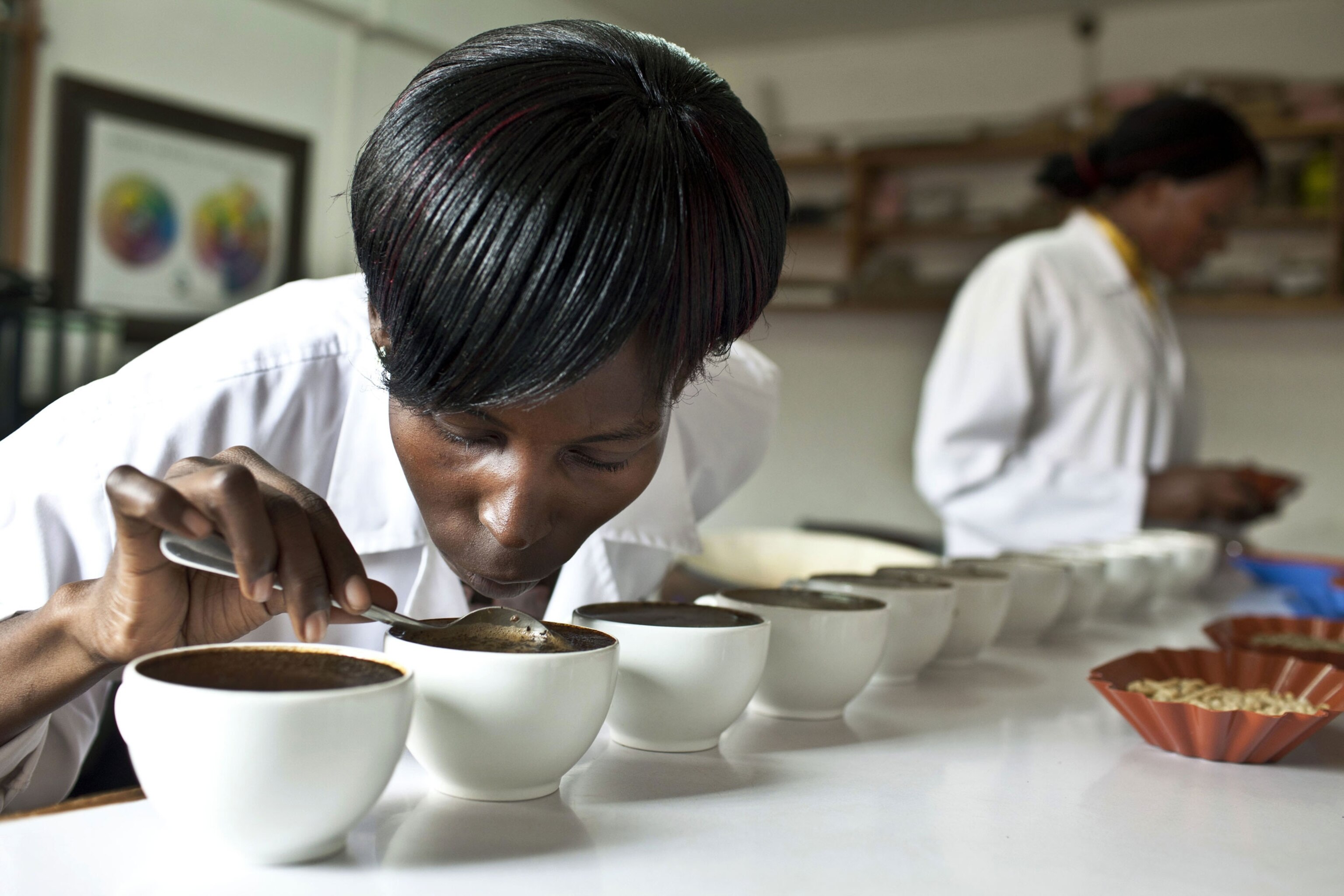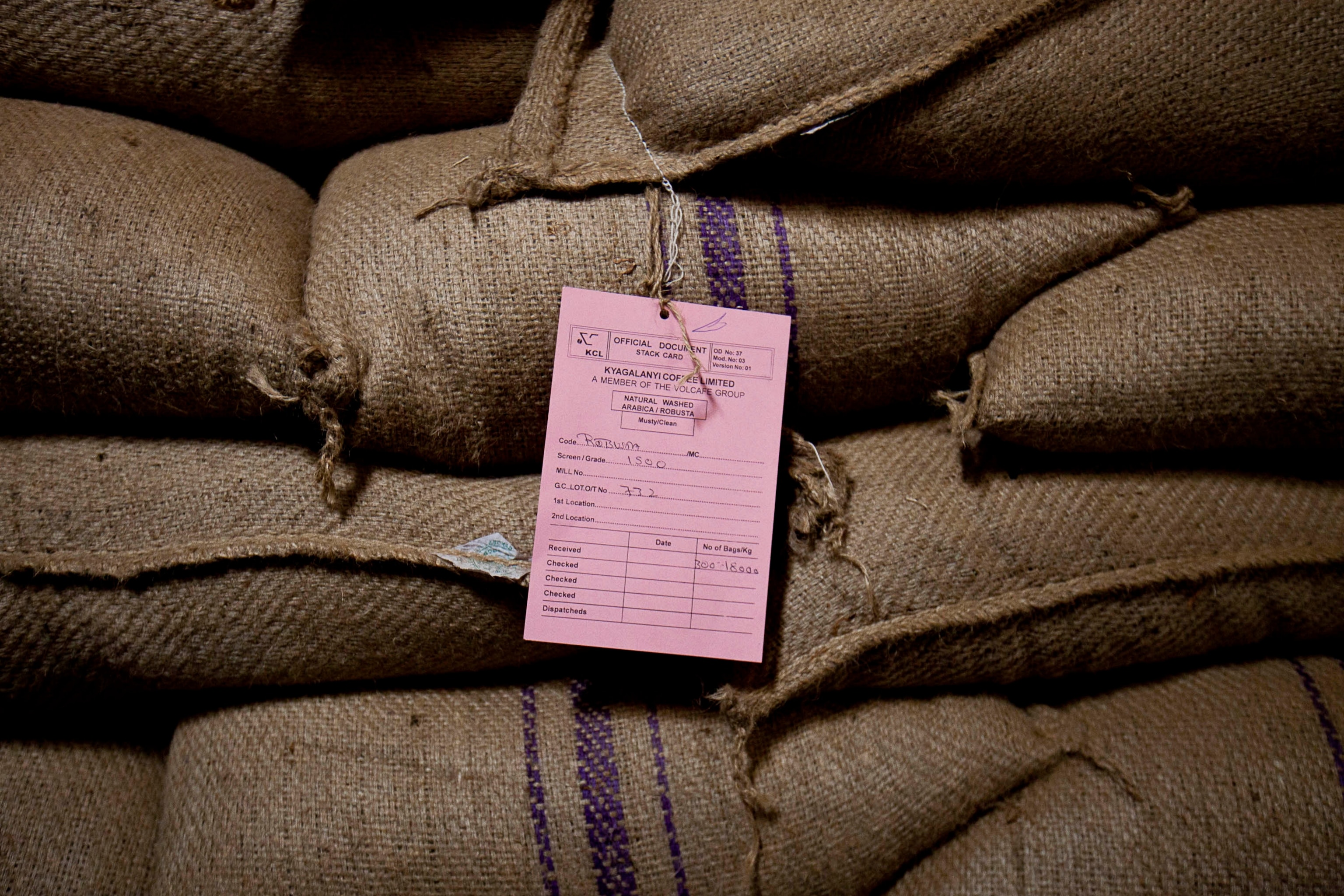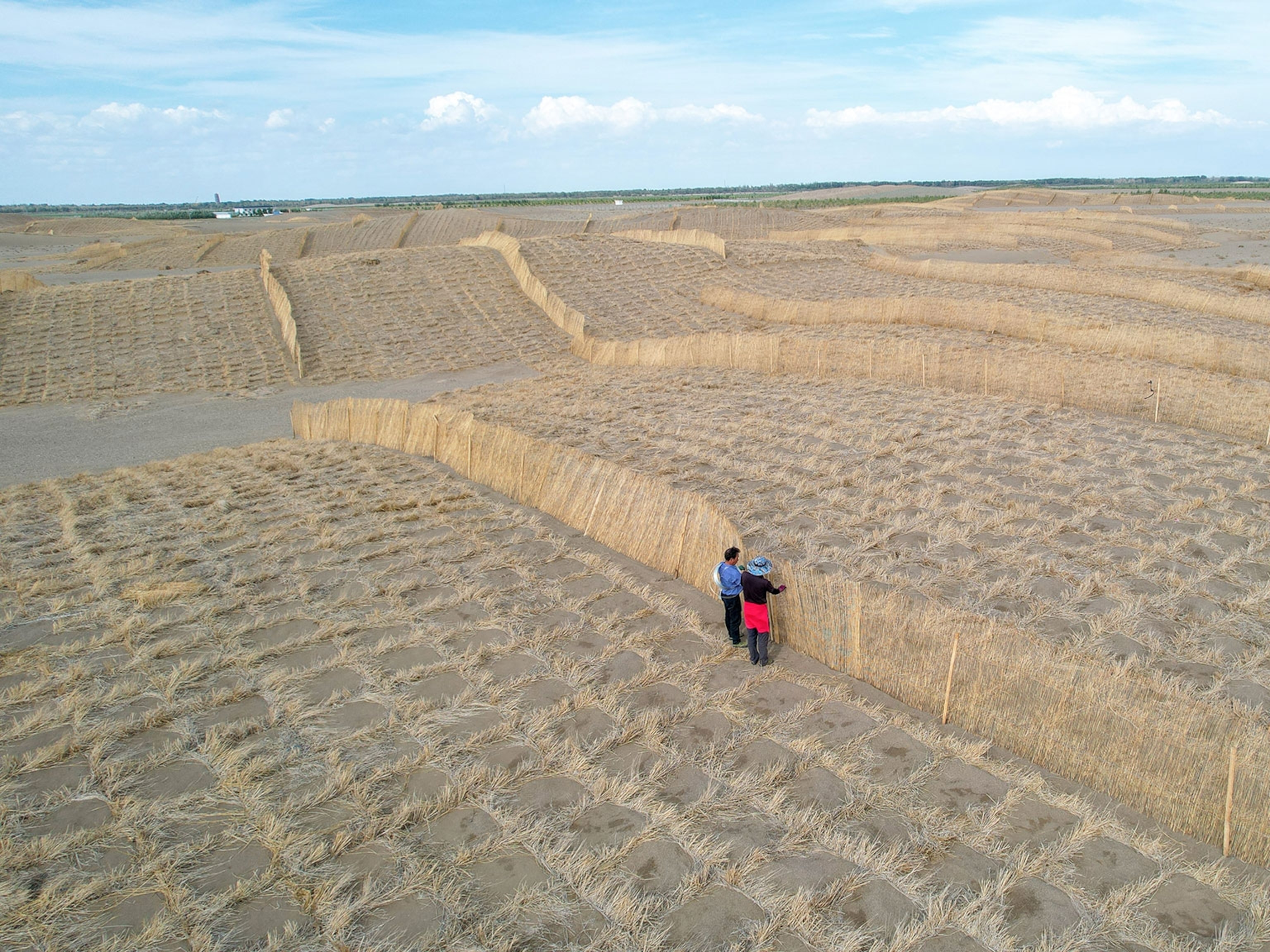A Drying Climate Threatens Africa’s Coffee, But Hope Remains
Uganda is pinning its hopes on its most valuable crop, though climate change is an obstacle to overcome.
Uganda — Sam Massa doesn’t drink coffee. Like many Ugandans, he prefers milky spiced tea. Yet, like many Ugandans, he says, “we are part of the coffee, and the coffee is in our blood.”
Massa lives at the top of an extinct volcano that straddles the border between Uganda and Kenya, in a small mud-brick house at the center of a grove of coffee trees. Some of the trees were planted here by his great-grandfather more than 100 years ago. Like his ancestors, Massa is a coffee farmer, and derives nearly all of his annual income from the produce of those trees, some of which ends up in the cups of coffee drinkers in the U.S. and other distant lands.
This place is among the oldest and most venerated coffee-producing regions of East Africa. The air is fresh and cool, the slopes studded with sweeping vistas and sparkling waterfalls. But trouble is coming up the mountain. In fact, it’s already at Massa’s door.
Uganda historically has two rainy seasons, from March through May and from October through December. Small farms in East Africa, like Massa’s, are almost exclusively without irrigation, meaning that reliable rainfall is a prerequisite to produce crops, including coffee. But in 2016, Massa’s area received almost no rain during the second season, and when it came time to harvest coffee in January, the yield was very poor. This was no freak accident, he says: In the last few years, the weather has been all wrong.
“Over the last, say, twenty years, the rain pattern has completely changed,” he says. “Rain comes at a time when you don’t expect it. Sunshine or drought come at time when you should be having rain.”
As a result, Massa’s household is suffering. Meals are simple and small, usually centered around home-grown bananas. Medication is a rare luxury. Purchases of tools and fertilizer needed for the upcoming planting season are on hold. Most distressingly to Massa, he is only able to afford to send four of his five children to school. The eldest, a teenage boy who should be the equivalent of a high school junior, is living at home.
Besides his coffee trees, Massa once had another prized possession: A well-fed cow that lived in a shed adjacent to the house and provided valuable milk. But after the disappointing coffee harvest, Massa sold the cow to pay his son’s school fees.
“There was nothing I could do,” he says. “God willing, He’ll send me another cow.”
Coffee and Climate
Massa’s story would be familiar to many coffee farmers in Uganda, and around the world. Coffee is highly vulnerable to climate change. Rising temperatures and increasingly erratic rainfall are already exposing trees to more pests and diseases, and decreasing both the quantity and quality of the crop, according to a global survey of coffee research published in September. Overall, the survey found that climate pressure could reduce the area suitable worldwide for coffee production 50 percent by 2050. That would be a devastating blow to the global coffee supply, which is already struggling to keep pace with rising demand. A paper published in Nature in June made similar dire predictions for Ethiopia, driving home the point for East Africa.
For coffee addicts in the U.S. and Europe, these impacts will likely manifest as a slightly higher bill for a slightly worse cup of coffee. But for the world’s 25 million coffee farmers, most of whom are smallholders like Massa whose fortunes rise and fall with the harvest, the consequences will be much more dire.
Uganda is especially vulnerable, because coffee is the country’s economic cornerstone. Now, scientists, government officials, farmers, and entrepreneurs, from the top of Mount Elgon to downtown Kampala to remote areas still reeling from warlord Joseph Kony, are scrambling to save the industry from climate change.

Uganda’s Big Gamble
Uganda ranks number eight worldwide in coffee production by volume, on par with Peru, and second in Africa after Ethiopia. Uganda typically produces 3-4 million 60-kilogram bags of coffee each year, which accounts for only two to three percent of global production and is far below behemoths like Brazil (55 million bags) or Vietnam (25 million). The majority of what Ugandan farmers grow is Robusta, a relatively low-quality variety that is often used for mass production—think Folgers, rather than your local hipster roastery.
Nevertheless, over the past century, coffee here has advanced into Uganda’s most important and valuable industry, worth more than $400 million. It’s responsible for at least 20 percent of the country’s export revenue, and according to the Uganda Coffee Federation, one in five Ugandans, nearly eight million people, derive most or all of their income from coffee. Roughly 90 percent of the country’s coffee is produced by smallholders like Massa.
President Yoweri Museveni, who has ruled Uganda since 1986 and cultivates a folky farmer-statesman persona, refers to coffee as an “anti-poverty crop” and is pushing an ambitious (and according to many experts here, completely unattainable) goal of increasing production five-fold, to 20 million bags by 2020. Coffee demand worldwide is projected to double by 2050, and Uganda wants in. It could be a solution to a variety of chronic social problems, particularly the rural poverty and food insecurity that afflict one-quarter of the population, and a $3.3 billion trade deficit (Uganda spends twice as much on petroleum imports as it earns from coffee).
But challenges abound, even without climate change. Farmers often lack access to basic equipment like fertilizer, irrigation, and high-quality seeds; services like bank loans, agricultural training, and market data; and infrastructure like paved roads and processing facilities. Most farms are small—the larger ones no bigger than a football field—and with a rapidly growing rural population, the land is divided into ever-smaller pieces. Weak land rights laws leave small farmers exposed to land grabs by wealthy neighbors or foreign investors. Many young people would rather try their luck in Kampala than follow their parents onto the farm. Women are frequently sidelined because land and household finances are traditionally controlled by men.
Overall, Uganda’s coffee farming practices have not advanced much since the time of Massa’s forebears, and farming incomes have stagnated among the lowest levels in Africa. As a result, farmers here are at a disadvantage to compete in a global market increasingly characterized by mechanization and unforgiving quality standards—and they’re entering the fight against climate change with one hand tied behind their backs.
Uganda’s average annual temperature has increased by 0.2 degrees Celsius per decade since the 1980s, on par with the global average increase. That rate is expected to quicken, such that the country could be up to another 2 degrees C warmer by mid-century than it is today. While the total amount of rainfall is not projected to change much, and may even increase in some parts of the country, the timing of the rains is increasingly unpredictable and characterized by long stretches of drought punctuated by downpours. A 2015 economic analysis commissioned by the government projected that because of climate change, without significant adaptive measures, Uganda’s coffee production will be cut in half by 2050, a loss adding up to $1.2 billion.
If that happens, for people like Massa, cows will be the least concern.
“We are deeply and broadly exposed to climate change,” says Joseph Nkandu, executive director of Uganda’s National Union of Coffee Agribusinesses and Farm Entrepreneurs (NUCAFE). If global warming continues on its current path, Nkandu says, all the fancy seeds and savvy farming practices in the world won’t be enough to save his constituents.
“We are trying our best. But there is a limit beyond which our trying can’t go,” he says.

Growing Resilience?
For now, Winfred Nakyagaba is preoccupied by the present. She’s an agronomy PhD student at the International Institute of Tropical Agriculture, a pan-African nonprofit research organization, studying the impact of heat and drought on coffee plants in central Uganda.
On a blistering day in late January, she toured small farms in Luwero, a major coffee-producing region just north of Kampala. Normally, at this time of year the rainy season would have just finished, and the trees would be lush and freshly harvested. But at the home of Gerald Joloba, a 47-year-old farmer who supports his wife and seven children with three acres of coffee trees, the leaves are brown and crisp to the touch.
When she finds a few cherries (the casing that encloses the coffee bean, so-called because when ripe they turn a vibrant red), they’re hard and black. Nakyagaba is flustered, stomping through the trees in rubber boots, picking at the leaves, and shaking her head. Everywhere she looks, she sees pin-sized holes left by a twig borer, an invasive insect that thrives in warm, dry weather and can suck the life out of a healthy coffee tree.
“If it had rained, these branches would be hanging down with cherries,” she says. “Now, the coffee has just become firewood.”
“The season has been very bad,” Joloba agrees. “It’s been four months without a good rain.”
Nakygaba also found record-breaking high temperatures in Luwero during the same period. Joloba could already judge the impact by his wallet. His harvest was down by 60 percent, and his annual income from coffee fell from the norm of more than $800 to less than $300.
Most of Luwero’s coffee farmers have similar stories, even though they are eager to experiment with various tactics for coping with drought. They plant new coffee trees in the shade of bananas to keep them cool and reduce evaporation; they dig pits around the base of each tree to act as catchments for any rain; they spread compost made of leaves onto the soil as mulch, which helps retain moisture; they bury water bottles next to each tree with a tiny hole pricked in the side, as an ad-hoc irrigation system. But those techniques only work up to a certain point.
“They have tried their level best,” Nakygaba says. “But it’s just too dry.”
Coffee’s sensitivity to rainfall makes it “among the worst crops farmers have in terms of exposing them to climate change shocks,” says Piet van Asten, a Kampala-based agronomist at Olam International, one of the world’s biggest coffee distributors.
Meticulously developed specialty seeds that require less rain, come to maturity more quickly, and resist infestation by diseases can improve farmers’ odds against worsening environmental conditions. These improved seed varieties are widely used in places like Brazil and Vietnam, but are rare in Uganda. They are relatively expensive and require know-how.
Self Organizing
That’s why Ruth Magambo decided the farmers will need to help themselves.
Magambo is the chairwoman of an all-female coffee farmer collective in Luwero that goes by the name Buki Naka, a mashup of the names of a few participating villages. The thirty members, who range in age from 30 to 65, meet weekly in a clean-swept storage shed at Magambo’s house to talk about coffee, and how smallholder farmers—particularly women—can work together to make the most of a bad situation.
Throughout Uganda, coffee is considered a “man’s crop,” meaning that husbands typically own the land and the trees, and keep the profit even if their wives perform a majority of the labor, which is often the case. Buki Naka’s members are rare exceptions: Some are widows who inherited trees from their husbands; some earned enough cash through petty trade to buy their own small plot of land; and some were gifted trees by forward-thinking living husbands.
The group first started meeting casually in 2007, as a place to swap coffee farming tips and neighborhood gossip. But two years ago, Magambo says, members were starting to panic because of worsening coffee yields that were leaving their households broke. So they decided to get serious about improving their business model. The first step was to start selling their coffee as a group in bulk, which reduces overhead costs and puts them in a stronger bargaining position to get a higher price from middlemen.
“As a group, we can earn more,” Magambo says. “This season has not been good because of drought, and the yield was low. But we earned more per kilo [than if we had negotiated individually].”
They also set up an internal lending bank. Between contributions and interest, Magambo says, the fund grows by up to $1,400 per year, equivalent to several households’ combined annual income. The loans are used for farm improvements like seed, to cover household expenses like school fees and maize flour when coffee income is low, and even to buy land.
Several members said that before the loans were available, they had secretly siphoned off coffee from their husband’s trees to sell for cash to make routine household purchases, just to avoid having to beg for an allowance. Now, they have a measure of financial independence.

When women are empowered to take a more direct role in managing the farm, they can boost household income and implement their own solutions for climate adaptation, says Fortunate Paska, a Ugandan gender researcher at the Hanns Neumann Foundation. Conversely, “if you don’t involve the women, nothing will get done, because they are the ones doing the work on the farm.”
Buki Naka’s members are leading an effort to bridge the gender gap in Luwero by organizing group meetings with men to make the case for joint coffee management.
“It’s good for the development of the household,” Magambo says. “Because women can take on the men’s role of paying for things, [men] should be able to see that they benefit too.”
The first stop Magambo’s coffee makes is right down the road, at a small shelling factory in a one-room warehouse in Luwero town. In the dark, a two-story machine let out a deafening drone as it sucked in dried cherries and belched suffocating clouds of torn-up shells.
One of the workers asked me where I was from; when I said the U.S., he pointed to a pile of beans and responded that “someday those will go to your country.” But as for what would happen to them once they reached their destination, he was unsure.
“What do muzungus do with all this coffee?” he asked, using the generic East African slang for “foreigners.”
“Well, we drink it,” I said.
“Right, but what else?” he said.
“Actually, that’s kind of the only thing,” I responded.
He gave me a funny look, as if I had just confirmed all his worst suspicions about the absurdity of foreigners. He was incredulous about the idea that this whole industry could exist just to produce a drink. When I asked if he ever drank coffee, he laughed.
“We don’t even have money to buy Nescafe,” he said.
The conversation illustrated one of the biggest roadblocks to the growth of Uganda’s coffee industry: Ugandans just don’t drink it. Ninety-five percent of Uganda’s coffee is exported as raw green beans, which demand a much lower price on the international market than the finished, ready-to-brew product. Without a domestic market, all the potential profit from roasting and marketing the finished product is reaped by a European or American instead of a Ugandan. President Museveni recently characterized the situation as “modern day slavery.” But entrepreneurs like Gerald Katabazi believe they can break those chains.
Can “The Hustler” Make Ugandan Coffee Cool?
Among Uganda’s small but tight-knit circle of baristas and enterprising coffee roasters, Katabazi is known as “The Hustler,” a nickname he works hard to deserve. He’s a man in constant motion, either criss-crossing the country in search of beans or zipping across Kampala on a boda-boda (motorcycle taxi) in search of partners and customers to unlock Uganda’s domestic coffee market.
Katabazi runs Volcano Coffee, a start-up roastery that provides high-end, ready-to-brew coffee to a variety of shops and cafes around Kampala. He’s been around coffee his whole life, having grown up in a farming village in Uganda’s verdant southwest. But like the skeptical factory worker in Luwero, the end-use of the crop was a mystery to him.
It wasn’t until his early 20s that he realized the true extent of the coffee industry, when a family friend connected him to a job as an office assistant at UCDA, the government coffee promotion agency. There, for the first time, he learned about quality control, the unforgiving demands of the export market, roasting, and how to pull an espresso shot. He also sampled his first cup of non-Nescafe coffee, and fell in love with it. But he was disheartened by what he saw as an overwhelming focus on exports.
“Our consumers are tea drinkers, not coffee drinkers,” he says. “We haven’t established [local] markets for our roasted beans.”
If Ugandans just processed and drank more of their own coffee, he thought, they could create jobs and keep more of the crop’s value in the country. By roasting and serving locally, “I’m creating a job for the roaster, a barista, a manager,” he says. “I’m adding value.”
Katabazi isn’t the only one with this idea. NUCAFE, the lobbying group, estimates that if Uganda were to roast and package all of the beans it currently exports raw, it could more than quadruple annual export revenue to $2 billion.

One vital incubation chamber for this emerging industry is in a bland beige warehouse on the outskirts of Kampala. The long hall inside is whitewashed and sterile, but thick with the mouthwatering aroma of freshly roasted coffee. A team of technicians are hunched over a stainless steel table, meticulously sorting coffee beans by color and quality. Behind them, another technician peers through a window into a hulking black roasting oven, monitoring beans as they cook from green to dark brown.
The facility is owned by Makerere University and functions as a kind of co-working space for coffee entrepreneurs. Katabazi is here to sample a batch of beans he just bought from a dealer in Mbale, the town at the base of Mount Elgon. The ritual, known as “cupping,” is how coffee companies first encounter the flavor profile of a new harvest, analogous to a winemaker pouring the first glass from a newly opened barrel.
Enough of Katabazi’s beans are roasted to brew a dozen cups, and then the tasting begins. We move clockwise around the table, dipping spoons into each cup, slurping and swirling the brew over our tongues, then, just like a wine tasting, spitting it out into a bucket.
“We look for the intensity of the fragrance,” he says. “Some strawberry, potato, and also some butter. It has a good aftertaste, low acidity. You just feel mild tingling at the sides of your tongue.”
Satisfied, Katabazi says he’ll call his contact in Mbale to order a bigger shipment of the beans. There’s a moral imperative to transform this nation of coffee farmers into coffee addicts, one cup at a time, he says: “We must be the future that will make things happen in Africa.”

An Unlikely Setting for Coffee’s Future
Will coffee be able to offer that future for Uganda? Even where there’s a shortage of rain, there’s never a shortage of optimism.
Judith Otto is the embodiment of Ugandans’ resilience. She lives in a rural area outside the town of Gulu, in the northern reach of the country. It’s an arid place with deep scars from decades spent as ground zero of the terrorist insurgency wrought by the Lord’s Resistance Army and its infamous chief, Joseph Kony.
For two decades, Otto and her neighbors were caught in the crossfire between Kony and government soldiers. Between 1987 and 2007, when the LRA was finally pushed out of Uganda, at least 20,000 children were abducted, 1.9 million people displaced from their homes, and tens of thousands of civilians killed, according to Human Rights Watch.
“The insecurity was so bad that sometimes we would sleep in the bush” to hide, Otto says.
The nightmare finally came to her home late one night in 2003, when her 16-year-old son opened the door and found an LRA militant standing there. Without a word, the man drew his AK-47 and fired into the house, killing that son and and another, 20 years old, standing nearby. While Otto, her husband, and their four other children escaped out the back, the militants set the house and farm ablaze. The family ran and didn’t return home until 2015.
When they did, they found their home gone, and the farm consumed by the surrounding forest. But they set to work rebuilding, selling the foliage they chopped down as firewood to raise cash. Prior to the conflict, her husband had planted a few coffee seedlings he’d been given by a friend. They were gone now, but when her husband heard about the government’s seedling distribution program, he decided to get some for himself.
Gulu is not an obvious setting for a coffee boom. Farming conditions are even less favorable than in Luwero, and experts expect them to worsen.
But Otto and her husband’s relative success challenge that belief. In just two years, they have rebuilt their farm and parlayed the free seedlings, plus others they bought and borrowed, into a plantation with more than one thousand trees.
On the foundations of their ruined house they’re building a bigger, modern concrete home with red windows and doors, using their income from coffee. Otto sits on the porch next to a panting yellow dog, looks out at her reclaimed land, and describes her house as a monument to possibility.
“We wouldn’t have this house without coffee,” she says. “Coffee saved us.”
Tim McDonnell is a former Fulbright-National Geographic storyteller who spent several months gathering the stories of African farmers. You can follow his journey on the Voices blog, and on Twitter @timmcdonnell and Instagram @timothy.m.mcdonnell.








